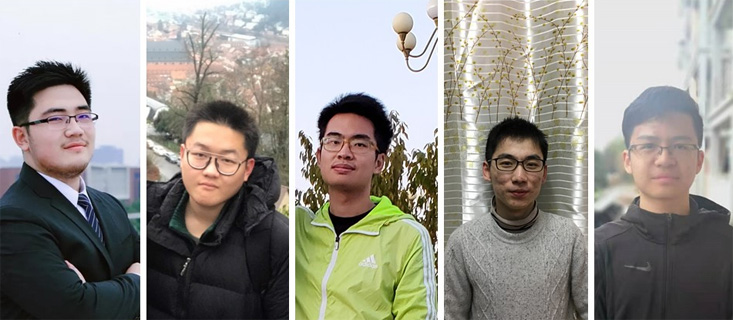
Student Projects
VE/VM450

5G 8K VR Enabled Smart Education
Instructors: Prof. Chong Han
Team Members: Zeyu Jian, Kecheng Qian, Yanyu Zhou, Zhe Yang, Yichao Wang
Team Members: Zeyu Jian, Kecheng Qian, Yanyu Zhou, Zhe Yang, Yichao Wang
Project Video
Team Members

Team Members:
Zeyu Jian, Kecheng Qian, Yanyu Zhou, Zhe Yang, Yichao Wang
Instructors:
Prof. Chong Han
Project Description
Problem
The situation of COVID-19 has stressed the importance of social distancing like teaching online. However, the existing online teaching has many drawbacks, such as low video quality, not-immersive experience, lack of interactions, etc. To solve these problems, this project aims to introduce a portable, inexpensive, clear-vision and user-friendly smart education platform with corresponding equipment.
Concept Generation
The major parts of this project are the following: Camera for video shooting, VR glasses, and smartphone apps. After researching and benchmarking, the selected best concept is composed of a VR camera (Kandao QooCam 8K), VR glasses (Cardboard) and own-developed smartphone application (Smart Education App).
The live streaming setup and all equipment used are photographed in the following figure.
The live streaming setup and all equipment used are photographed in the following figure.

Fig. 1 VR streaming setup
Design Description
A VR camera records the lecture scene sends the live streaming signal to our cloud server. Three devices require the processed video signal from the cloud. The teacher end app and demo monitor require the panoramic signal, while the student end app requires the VR signal.
Besides showing the video, our apps can enable students and teachers to have interactions. Moreover, our student end app use the built-in gyroscope and collect the related data to our cloud database while students are using the VR glass. These data can be used to find patterns of students’ behaviors and focuses.

Fig.2 Concept Diagram

Fig.3 Demonstration of Application
Manufacturing
The VR camera and VR glasses is directly purchased, but in the future manufacturing, the VR glasses can be re-constructed with Cardboard and two lens, which can further reduce the cost and develop other functions.
The smartphone application is developed in Android Studio using java as the programming language.
The set of Apps include four main functions: VR player, register and login, interaction, and gyroscope dataset collection. A server supports all the above functions.
The smartphone application is developed in Android Studio using java as the programming language.
The set of Apps include four main functions: VR player, register and login, interaction, and gyroscope dataset collection. A server supports all the above functions.
Validation
Validation Process:
For delay, turn on the VR camera and start streaming, then open Student App and Teacher App. Set a timer in front of VR camera and start it, then watch the two Apps until the timer in the screen starts counting. The time in front of VR camera is delay.
For resolution, set VR camera 2 meters in front of a blackboard, and the validation test is passed if the characters can be identified clearly on Student App.
For interaction, click “raise hand” button in the Student App. If data on Teacher App changes simultaneously, then the test is also passed.
Validation Results:
√ Delay: 18s
√ Resolution: Up to 3840*1920
√ Interaction: Real time (10ms)
√ VR glasses cost: 30RMB
√ VR glasses weight: 60g
√ Transmitting method: Wi-Fi & 4G
(√ means having been verified)
For delay, turn on the VR camera and start streaming, then open Student App and Teacher App. Set a timer in front of VR camera and start it, then watch the two Apps until the timer in the screen starts counting. The time in front of VR camera is delay.
For resolution, set VR camera 2 meters in front of a blackboard, and the validation test is passed if the characters can be identified clearly on Student App.
For interaction, click “raise hand” button in the Student App. If data on Teacher App changes simultaneously, then the test is also passed.
Validation Results:
√ Delay: 18s
√ Resolution: Up to 3840*1920
√ Interaction: Real time (10ms)
√ VR glasses cost: 30RMB
√ VR glasses weight: 60g
√ Transmitting method: Wi-Fi & 4G
(√ means having been verified)
Conclusion
VR technology enables students to be more concentrated and immersed in class. The key to build a satisfactory online education system is to solve the problems of delay and resolution, while interactions can improve the effect. 5G reduces the delay and gyroscope data helps study the users’ behavior.
Acknowledgement
Instructor & Sponsor:
Chong Han from Terahertz Wireless Communications (TWC) Laboratory, UM-SJTU Joint Institute
Chong Han from Terahertz Wireless Communications (TWC) Laboratory, UM-SJTU Joint Institute
UM-SJTU JOINT INSTITUTE